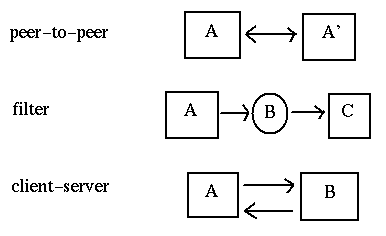Distributed Computing Models
At the highest level, we could consider the equivalence or the non-equivalence of components of a distributed system. The most common occurrence is an asymmetric one: a client sends requests to a server, and the server responds. This is a client-server system.
If both components are equivalent, both able to initiate and to respond to messages, then we have a peer-to-peer system. Note that this is a logical classification: one peer may be a 16,000 core mainframe, the other might be a mobile phone. But if both can act similarly then they are peers.
A third model is the so-called filter. Here one component passes information to another which modifies it before passing it to a third. This is a fairly common model: for example, the middle component gets information from a database as SQL records and transforms it into an HTML table for the third component (which might be a browser).
These are illustrated as:
